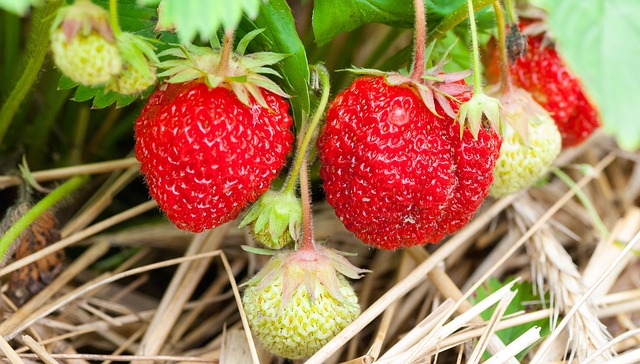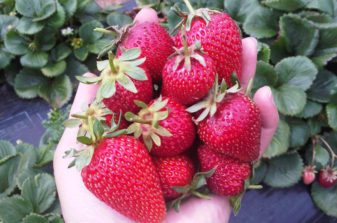 Strawberries – the Luscious Taste of Summer!
Strawberries – the Luscious Taste of Summer!
Strawberries are delicious! And when they come from your own garden, they taste even more delicious. Now’s the time to get your strawberries started. The information tells you to wait to harvest the second year but we won’t tell anyone if you harvest and eat them the first year instead!
The strawberry’s incomparable sweet fragrance, fresh red color and superb flavor are the essence of summer. One of the few fruits that originated in the United States, it is nearly everybody’s favorite berry. About 7 inches tall with roundish green leaves and white flowers, the plants are pretty enough for pots and planting dishes.
Varieties
Many new varieties have been developed in the short time the strawberry has been in cultivation; most require two years in the ground to produce fruit. Though spring-planted everbearers produce a heavy crop over a period of weeks and then a scattering of berries the rest of the season, standard varieties develop fruit buds in summer and fall for the next spring or summer crop. Standard varieties may ripen very early, early, midseason or late summer. Pick the variety that you think you will like, as standard varieties produce all of their fruit at one time, making this type of berry an excellent candidate for canning, jellies, and jam. Buy only certified virus-free plants.
Where to Plant
Strawberry plants prefer a sunny location with good air circulation and some wind protection. Plant them in well-drained soil that is slightly acidic and full of rich humus. Be sure the area is cleared of any grass or weeds that will compete for nutrients and moisture. It’s best to put the plant in soil that has already been used for other cultivated crops for a year or more; this deters white grubs.
Planting
In southwest Michigan plant strawberry plants in very early spring, as soon as the soil becomes workable. For a big harvest, put plants in rows.
You may treat strawberry plants as biennials, planting one year, harvesting and plowing under the next. A second, less-used option is to treat them as the perennials they are, allowing them to continue producing year after year until the harvests wane.
Planting strawberry plants as biennials is best in areas where the winter cold is severe. For this planting method, leave 3 or 4 feet between rows and 18 inches between plants. Firm the soil around the roots and water the plants well. Allow the plant-producing runners to grow freely, but steer them so they grow toward their adjoining plant, take root, and fill in to make a row matted with strawberry plants. Harvest the following year, and then plow under. If the plants are kept a third year, new plants will overcrowd the bed, resulting in a small crop of small, hard berries
To plant strawberry plants as perennials requires more attention, but where soil and exposure are ideal, the bed may stay productive for as long as 5 years. In less favorable circumstances, you’ll need to renew the planting more often. Put the plants 12 inches apart in 3 rows spaced 12 inches apart. Cut off all runners as soon as they form and allow no new plants to grow. This diverts the plant’s energy into producing large berries.
With either planting method, it’s important to set the plants in the ground at the exact level at which they grew before. The crowns should be above the soil level and the topmost roots should be ¼ inch beneath the soil surface. Otherwise, buried crowns will rot and exposed roots will dry out.
Culture
After the plants are in the ground, mulch with a layer of straw or pine needles to give them insulation and keep the berries clean, the soil moist, and the temperature even. A pine needle mulch will discourage sow and pill bugs, which often cause trouble at fruiting time. Mulching will also help control weeds.
Feed strawberry plants when growth begins and again after the first crop is harvested. Consult your nursery expert for the best fertilizer to use in your region. The pH preference for strawberries is 5.0 – 7.5.
Strawberry plants need frequent deep soakings, especially during fruiting season. Water plants growing in sandy soil every 2 to 3 days; water plants growing in heavy soil every week to 10 days. Each plant yields ½ to 1 quart of strawberries.
Here are a few tips:
- Harvest strawberries the day they ripen as they spoil quickly. To keep them fresh longer, pick berries in the cool air of early morning and store them, unwashed, in the refrigerator. Clean them shortly before eating; wet berries spoil faster.
- Pinch the first blossoms off plants to prevent them from setting fruit the first year and producing inferior berries later. Remove all blossoming stems, pinching them off at the base of the plant.
- Buy virus-free plants to deter most diseases. To repel certain insects, some strawberry growers plant a marigold between every plant or feather the fruiting stems among the leaves to prevent ground contact. Don’t spray set plants.
- Pesticides and herbicides not used according to label directions can be harmful to humans, animals and plants. Only use products that have directions for home and garden use.
- A good practice would be to use organic fertilizers and pesticides on anything you are going to eat…


